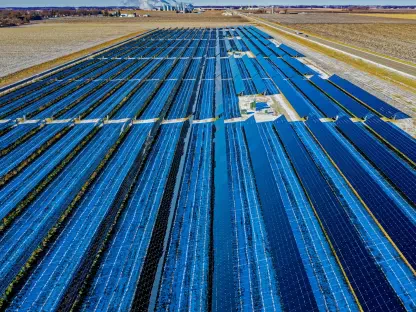Georgia Power’s 2025 Integrated Resource Plan (IRP) has recently been approved by utility regulators amid significant debate and scrutiny. This plan is a pivotal document outlining Georgia Power’s approach to addressing the state’s growing energy demands, primarily fueled by the rapid expansion of the data center industry in the Atlanta metropolitan area. The plan reflects a complex strategy combining the continued use of coal with investments in renewable energy sources over a six-year span. With increasing pressure on utilities to balance economic needs with environmental responsibility, Georgia Power’s plan becomes a crucial canvas for exploring these priorities.
The Role of Coal and Renewables in the IRP
Balancing the Legacy of Coal with Renewable Aspirations
At the heart of the IRP lies a contentious decision to keep Georgia Power’s existing coal plants operational to meet the anticipated surge in energy demand, predominantly from data centers. While the proposal includes bringing up to 4,000 MW of renewable energy capacity and 1,500 MW of battery storage, a smaller portion is reserved for new gas capacity. The plan projects a significant load growth of approximately 8,500 MW over the upcoming years, a figure holding considerable weight in shaping the state’s energy landscape.
Complementing the traditional energy approach, renewable resources play a significant role in the IRP. However, several clean energy advocates have expressed criticism. They argue that the reliance on coal undermines efforts towards reducing carbon emissions. These critics point out that despite progressive steps in solar and battery storage inclusion, the plan’s primary investment remains tied to fossil fuels. These concerns raise vital questions regarding the balance of energy resources and whether Georgia Power is too anchored in conventional energy strategies to adequately address Georgia’s evolving energy needs.
Monitoring and Critiques of Energy Growth Projections
Georgia Power’s forecasts of massive growth in energy consumption underpinning the IRP rest on the burgeoning needs of data centers. But new mechanisms have been put in place to ensure transparency and accountability. Regular updates to projected load figures and quarterly filings will monitor these developments. However, some critics question the accuracy and reliability of the company’s projections. Industry experts voice skepticism over potential disparities between perceived and actual data center expansion rates within Georgia. If these high growth projections don’t materialize, communities may face increased utility costs, raising concerns about the fairness and foresight of the plan.
Public control mechanisms represent a double-edged sword. On one hand, they provide assurance of public engagement in scrutinizing and updating forecasts. Yet, when faced with criticism from environmental groups, these methods could be perceived as insufficient in driving Georgia Power’s more sustainable transition. The IRP projects a future path filled with opportunities but also challenges that need meticulous management to balance consumer impact with the broader environmental footprint.
Strategic Choices for Utility and Consumer Needs
Regulatory Views on the Future Energy Mix
From a regulatory perspective, the IRP sets an ambitious roadmap for Georgia’s energy future, emphasizing a minimum addition of 6,000 MW of new energy production capacity through various sources. This approach aligns with the anticipated rise of data centers across the state. PSC Chairman Jason Shaw champions this as a strategic means to safeguard Georgia’s capacity to meet increasing energy demands while balancing cost and reliability. Georgia Power’s commitment to nuclear energy projects further supports this comprehensive plan, signifying continued investments in nuclear plant upgrades and capacity enhancements.
Despite support for strategic investments in nuclear and renewable sources, the IRP faces notable contention over its sustained commitment to fossil fuels, specifically at the Scherer and Bowen coal plants. Extending operations of these plants beyond initial shutdown dates to 2038, with prospects of co-firing with natural gas, ignites opposition from those advocating for a more rapid transition to sustainable energy sources. The doubling down on fossil fuel dependency remains a key dividing line in assessing Georgia Power’s path toward a balanced energy mix, revealing dialogue essential for determining the appropriate balance between energy security and environmental responsibility.
The Debate over Energy Efficiency
One contentious point in the IRP is Georgia Power’s stance on energy efficiency targets. The plan maintains a target of 0.5% savings, despite calls for an increase to 0.75% by environmental and consumer advocacy groups. Georgia Power has faced challenges in meeting even this modest target, contrasting with significantly higher efficiency averages achieved by other major U.S. utilities. Critics emphasize the critical role of energy efficiency in curtailing energy costs and mitigating environmental impact amidst surging electricity demands.
The persistence in minimal energy efficiency improvements by Georgia Power forms an area ripe for discussion surrounding its long-term commitment to sustainable practices. Ways to significantly enhance efficiency measures could unlock potential cost savings and environmental benefits. Advocacy groups continue to stress the need for heightened efficiency to complement overall energy supply strategies, pointing to successful implementations by peer utility companies as benchmarks for progress. The dialogue regarding efficiency remains a focal point in outlining paths toward genuinely sustainable energy strategies.
Contemplating Georgia Power’s Energy Path Forward
Georgia Power’s 2025 Integrated Resource Plan (IRP) has gained approval from utility regulators, marking a significant milestone after much debate and examination. This pivotal plan sets out Georgia Power’s strategy to meet the state’s increasing energy needs, largely driven by the swift surge of the data center industry in the Atlanta metro area. The IRP proposes a multifaceted approach that balances the continued use of coal with substantial investments in renewable energy over the next six years. This strategy reflects the growing pressure on utility companies to find equilibrium between economic development and environmental stewardship. The IRP is a fundamental blueprint that guides how Georgia Power plans to address these dual priorities. As the energy sector faces mounting expectations for sustainable practices, the plan is essential for understanding how Georgia Power intends to meet these challenges and support the region’s energy infrastructure both now and in the near future.









